Mengxi Guo
MambaCSR: Dual-Interleaved Scanning for Compressed Image Super-Resolution With SSMs
Aug 21, 2024Abstract:We present MambaCSR, a simple but effective framework based on Mamba for the challenging compressed image super-resolution (CSR) task. Particularly, the scanning strategies of Mamba are crucial for effective contextual knowledge modeling in the restoration process despite it relying on selective state space modeling for all tokens. In this work, we propose an efficient dual-interleaved scanning paradigm (DIS) for CSR, which is composed of two scanning strategies: (i) hierarchical interleaved scanning is designed to comprehensively capture and utilize the most potential contextual information within an image by simultaneously taking advantage of the local window-based and sequential scanning methods; (ii) horizontal-to-vertical interleaved scanning is proposed to reduce the computational cost by leaving the redundancy between the scanning of different directions. To overcome the non-uniform compression artifacts, we also propose position-aligned cross-scale scanning to model multi-scale contextual information. Experimental results on multiple benchmarks have shown the great performance of our MambaCSR in the compressed image super-resolution task. The code will be soon available in~\textcolor{magenta}{\url{https://github.com/renyulin-f/MambaCSR}}.
MoE-DiffIR: Task-customized Diffusion Priors for Universal Compressed Image Restoration
Jul 15, 2024Abstract:We present MoE-DiffIR, an innovative universal compressed image restoration (CIR) method with task-customized diffusion priors. This intends to handle two pivotal challenges in the existing CIR methods: (i) lacking adaptability and universality for different image codecs, e.g., JPEG and WebP; (ii) poor texture generation capability, particularly at low bitrates. Specifically, our MoE-DiffIR develops the powerful mixture-of-experts (MoE) prompt module, where some basic prompts cooperate to excavate the task-customized diffusion priors from Stable Diffusion (SD) for each compression task. Moreover, the degradation-aware routing mechanism is proposed to enable the flexible assignment of basic prompts. To activate and reuse the cross-modality generation prior of SD, we design the visual-to-text adapter for MoE-DiffIR, which aims to adapt the embedding of low-quality images from the visual domain to the textual domain as the textual guidance for SD, enabling more consistent and reasonable texture generation. We also construct one comprehensive benchmark dataset for universal CIR, covering 21 types of degradations from 7 popular traditional and learned codecs. Extensive experiments on universal CIR have demonstrated the excellent robustness and texture restoration capability of our proposed MoE-DiffIR. The project can be found at https://renyulin-f.github.io/MoE-DiffIR.github.io/.
PromptCIR: Blind Compressed Image Restoration with Prompt Learning
Apr 26, 2024Abstract:Blind Compressed Image Restoration (CIR) has garnered significant attention due to its practical applications. It aims to mitigate compression artifacts caused by unknown quality factors, particularly with JPEG codecs. Existing works on blind CIR often seek assistance from a quality factor prediction network to facilitate their network to restore compressed images. However, the predicted numerical quality factor lacks spatial information, preventing network adaptability toward image contents. Recent studies in prompt-learning-based image restoration have showcased the potential of prompts to generalize across varied degradation types and degrees. This motivated us to design a prompt-learning-based compressed image restoration network, dubbed PromptCIR, which can effectively restore images from various compress levels. Specifically, PromptCIR exploits prompts to encode compression information implicitly, where prompts directly interact with soft weights generated from image features, thus providing dynamic content-aware and distortion-aware guidance for the restoration process. The light-weight prompts enable our method to adapt to different compression levels, while introducing minimal parameter overhead. Overall, PromptCIR leverages the powerful transformer-based backbone with the dynamic prompt module to proficiently handle blind CIR tasks, winning first place in the NTIRE 2024 challenge of blind compressed image enhancement track. Extensive experiments have validated the effectiveness of our proposed PromptCIR. The code is available at https://github.com/lbc12345/PromptCIR-NTIRE24.
Optimal Transcoding Resolution Prediction for Efficient Per-Title Bitrate Ladder Estimation
Jan 09, 2024Abstract:Adaptive video streaming requires efficient bitrate ladder construction to meet heterogeneous network conditions and end-user demands. Per-title optimized encoding typically traverses numerous encoding parameters to search the Pareto-optimal operating points for each video. Recently, researchers have attempted to predict the content-optimized bitrate ladder for pre-encoding overhead reduction. However, existing methods commonly estimate the encoding parameters on the Pareto front and still require subsequent pre-encodings. In this paper, we propose to directly predict the optimal transcoding resolution at each preset bitrate for efficient bitrate ladder construction. We adopt a Temporal Attentive Gated Recurrent Network to capture spatial-temporal features and predict transcoding resolutions as a multi-task classification problem. We demonstrate that content-optimized bitrate ladders can thus be efficiently determined without any pre-encoding. Our method well approximates the ground-truth bitrate-resolution pairs with a slight Bj{\o}ntegaard Delta rate loss of 1.21% and significantly outperforms the state-of-the-art fixed ladder.
Video Compression with Arbitrary Rescaling Network
Jun 07, 2023Abstract:Most video platforms provide video streaming services with different qualities, and the quality of the services is usually adjusted by the resolution of the videos. So high-resolution videos need to be downsampled for compression. In order to solve the problem of video coding at different resolutions, we propose a rate-guided arbitrary rescaling network (RARN) for video resizing before encoding. To help the RARN be compatible with standard codecs and generate compression-friendly results, an iteratively optimized transformer-based virtual codec (TVC) is introduced to simulate the key components of video encoding and perform bitrate estimation. By iteratively training the TVC and the RARN, we achieved 5%-29% BD-Rate reduction anchored by linear interpolation under different encoding configurations and resolutions, exceeding the previous methods on most test videos. Furthermore, the lightweight RARN structure can process FHD (1080p) content at real-time speed (91 FPS) and obtain a considerable rate reduction.
Self-Asymmetric Invertible Network for Compression-Aware Image Rescaling
Mar 11, 2023Abstract:High-resolution (HR) images are usually downscaled to low-resolution (LR) ones for better display and afterward upscaled back to the original size to recover details. Recent work in image rescaling formulates downscaling and upscaling as a unified task and learns a bijective mapping between HR and LR via invertible networks. However, in real-world applications (e.g., social media), most images are compressed for transmission. Lossy compression will lead to irreversible information loss on LR images, hence damaging the inverse upscaling procedure and degrading the reconstruction accuracy. In this paper, we propose the Self-Asymmetric Invertible Network (SAIN) for compression-aware image rescaling. To tackle the distribution shift, we first develop an end-to-end asymmetric framework with two separate bijective mappings for high-quality and compressed LR images, respectively. Then, based on empirical analysis of this framework, we model the distribution of the lost information (including downscaling and compression) using isotropic Gaussian mixtures and propose the Enhanced Invertible Block to derive high-quality/compressed LR images in one forward pass. Besides, we design a set of losses to regularize the learned LR images and enhance the invertibility. Extensive experiments demonstrate the consistent improvements of SAIN across various image rescaling datasets in terms of both quantitative and qualitative evaluation under standard image compression formats (i.e., JPEG and WebP).
Towards Blind Watermarking: Combining Invertible and Non-invertible Mechanisms
Dec 24, 2022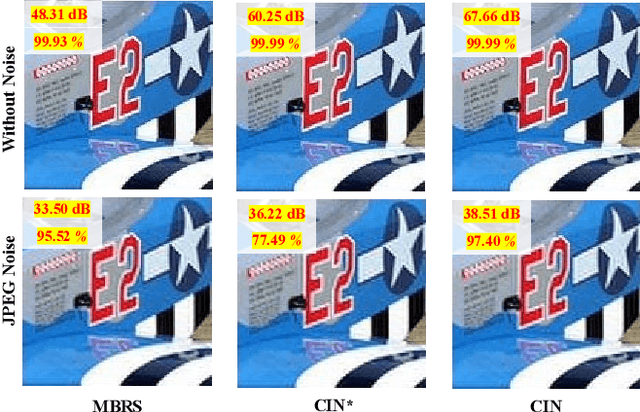
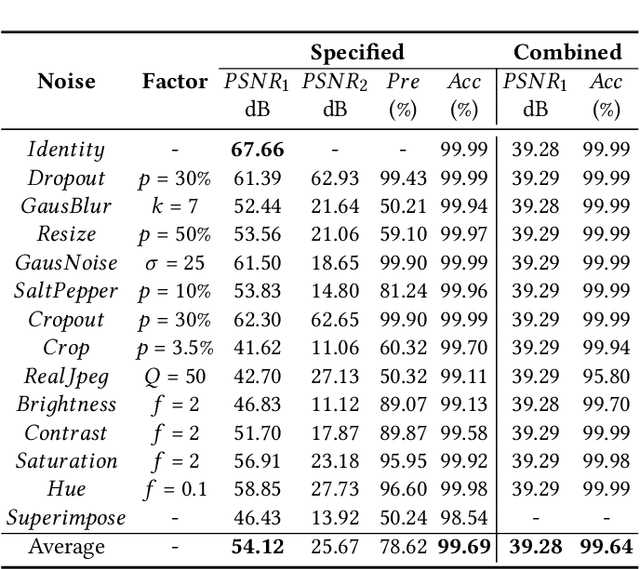
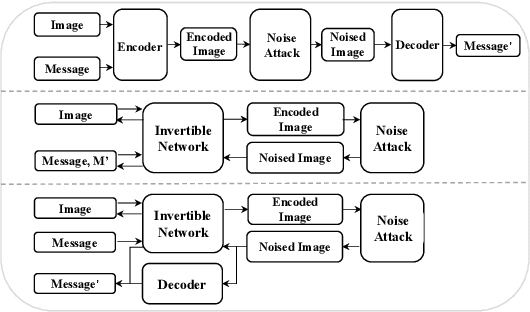
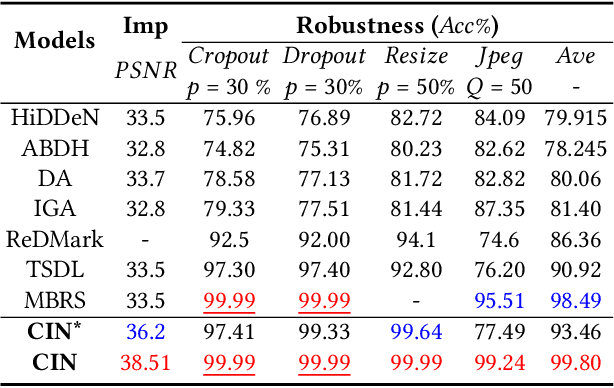
Abstract:Blind watermarking provides powerful evidence for copyright protection, image authentication, and tampering identification. However, it remains a challenge to design a watermarking model with high imperceptibility and robustness against strong noise attacks. To resolve this issue, we present a framework Combining the Invertible and Non-invertible (CIN) mechanisms. The CIN is composed of the invertible part to achieve high imperceptibility and the non-invertible part to strengthen the robustness against strong noise attacks. For the invertible part, we develop a diffusion and extraction module (DEM) and a fusion and split module (FSM) to embed and extract watermarks symmetrically in an invertible way. For the non-invertible part, we introduce a non-invertible attention-based module (NIAM) and the noise-specific selection module (NSM) to solve the asymmetric extraction under a strong noise attack. Extensive experiments demonstrate that our framework outperforms the current state-of-the-art methods of imperceptibility and robustness significantly. Our framework can achieve an average of 99.99% accuracy and 67.66 dB PSNR under noise-free conditions, while 96.64% and 39.28 dB combined strong noise attacks. The code will be available in https://github.com/rmpku/CIN.
The Layout Generation Algorithm of Graphic Design Based on Transformer-CVAE
Oct 08, 2021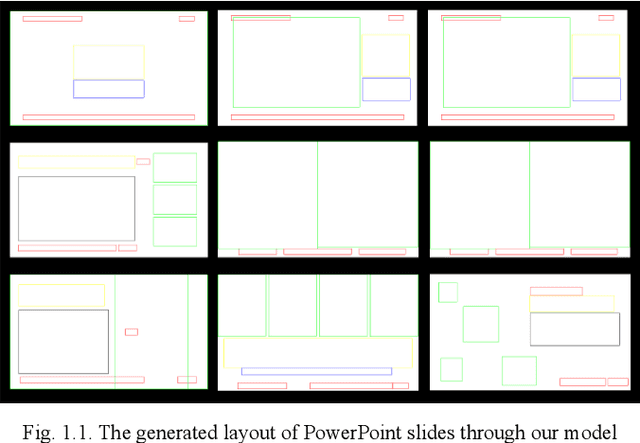
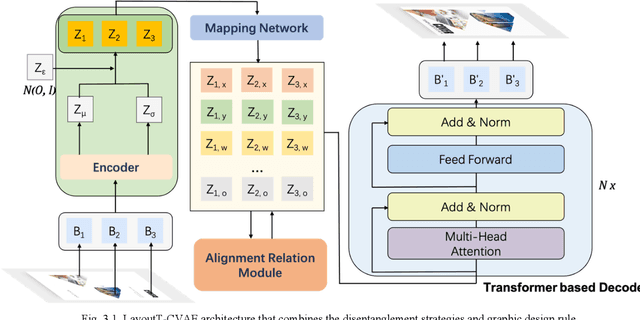
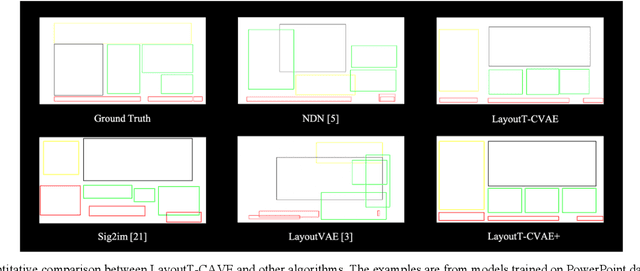
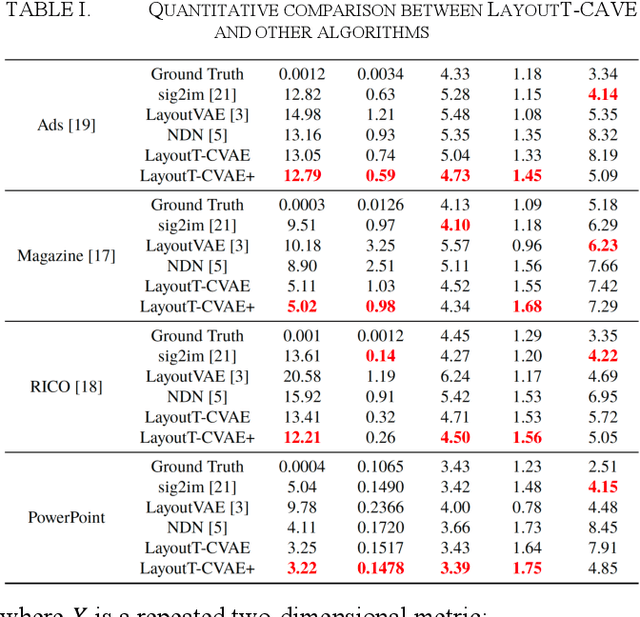
Abstract:Graphic design is ubiquitous in people's daily lives. For graphic design, the most time-consuming task is laying out various components in the interface. Repetitive manual layout design will waste a lot of time for professional graphic designers. Existing templates are usually rudimentary and not suitable for most designs, reducing efficiency and limiting creativity. This paper implemented the Transformer model and conditional variational autoencoder (CVAE) to the graphic design layout generation task. It proposed an end-to-end graphic design layout generation model named LayoutT-CVAE. We also proposed element disentanglement and feature-based disentanglement strategies and introduce new graphic design principles and similarity metrics into the model, which significantly increased the controllability and interpretability of the deep model. Compared with the existing state-of-art models, the layout generated by ours performs better on many metrics.
NTIRE 2021 Challenge on Quality Enhancement of Compressed Video: Methods and Results
May 02, 2021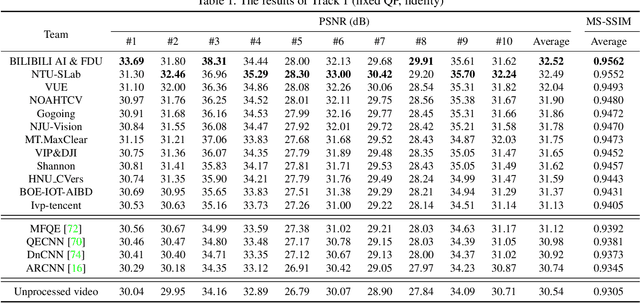
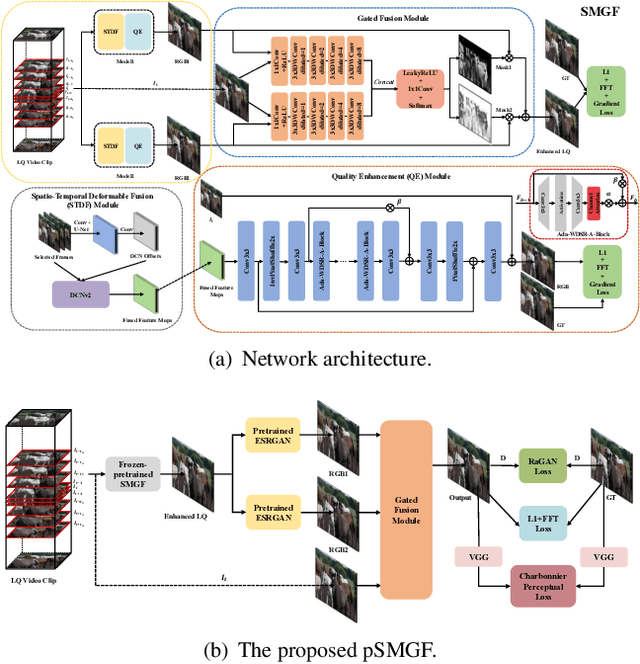

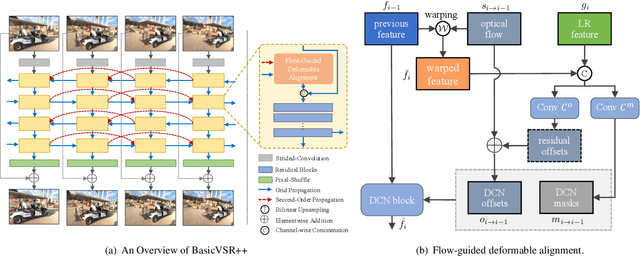
Abstract:This paper reviews the first NTIRE challenge on quality enhancement of compressed video, with a focus on the proposed methods and results. In this challenge, the new Large-scale Diverse Video (LDV) dataset is employed. The challenge has three tracks. Tracks 1 and 2 aim at enhancing the videos compressed by HEVC at a fixed QP, while Track 3 is designed for enhancing the videos compressed by x265 at a fixed bit-rate. Besides, the quality enhancement of Tracks 1 and 3 targets at improving the fidelity (PSNR), and Track 2 targets at enhancing the perceptual quality. The three tracks totally attract 482 registrations. In the test phase, 12 teams, 8 teams and 11 teams submitted the final results of Tracks 1, 2 and 3, respectively. The proposed methods and solutions gauge the state-of-the-art of video quality enhancement. The homepage of the challenge: https://github.com/RenYang-home/NTIRE21_VEnh
 Add to Chrome
Add to Chrome Add to Firefox
Add to Firefox Add to Edge
Add to Edge